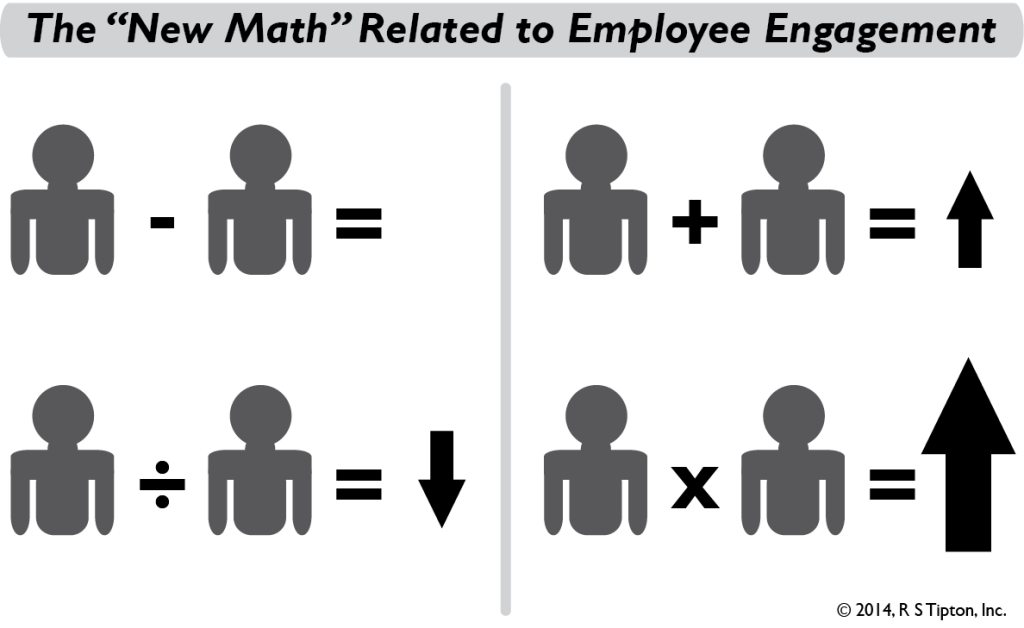“Low employee engagement is a competitive disadvantage.”
Bold assertion or obvious statement? To me it’s as obvious as the proverbial noses on our faces — a disengaged workforce means more absenteeism, higher voluntary turnover, and overall lousy productivity.
But, what are we doing about it? Usually the wrong things, I fear.
by Robert S. Tipton

What’s Happened To Us?
Two major shifts have happened in the past 10 years in our “go to work” culture — and both are based in the low-energy realm of fear, shame, threat and coercion.
First, we’ve become a “compliance-at-all-costs” society — and our auditors and lawyers seem to have disproportionate influence over business strategies. We focus TONS of energy on what might go wrong — and we leave little time or energy for what might go right. As such, we mostly live in the world of “avoiding problems” instead of the more balanced world of “finding solutions.”
Subtle difference, maybe… Or, maybe not — it’s all in the energy we bring!
Second, we’ve started relying primarily on training and performance management systems to drive organizational change. This by itself isn’t “bad” — but where’s the room for dreaming, for trying and failing, for REALLY operating outside of our status quo bias and our historical boundaries? I don’t see rewards for “try and fail” in many training / performance management systems these days.
It should be no surprise then, according to Gallup’s “State of the Global Workplace” survey (October 2013), that only 13% of our employees actually like going to work.
Egads.
Now what? Read on…
3 Transformational Strategies to Improve Employee Engagement
1) Recognize that Employees’ Strengths Can Be Developed Infinitely
Here’s a novel idea: “Let’s stop trying to get our employees to improve their weaknesses and let’s focus on helping them leverage their strengths instead.” Hmm… How counter-culture!
The research here is clear — trying to get employees to “fix” their weaknesses isn’t a transformational strategy, it’s an “incremental, marginal” approach. Why? Because our weaknesses can only be improved “so much…” As an example, if you’re an introvert, and your need for “self advocacy” is seen by someone in the HR department as a sizable weakness, the truth of the matter is that without a complete personality transplant, you’re only going to become somewhat better at speaking up.
Conversely, maybe the same introverted employee is exceptionally talented at spotting trends, or uncovering unseen synergies in market research. Why would we NOT focus on leveraging her/his strengths here?!? Beats me — I’m completely baffled by the notion that he/she needs to be much more self-advocating in order to be “in compliance” with her/his performance plan. What a waste of an employee’s strength!
 Anyway, according to Jim Clifton (Gallup’s CEO), “When employees work from strengths, nothing motivates them to achieve more — not money, not love, not vacations, not good benefits, not company volleyball games, not motivational speakers.”
Anyway, according to Jim Clifton (Gallup’s CEO), “When employees work from strengths, nothing motivates them to achieve more — not money, not love, not vacations, not good benefits, not company volleyball games, not motivational speakers.”
I’m not sure I like his thoughts about speakers (grin), but I agree with him completely about motivating employees. There’s nothing like amplifying our strengths to get us to bring our “A” games at work!
2) Focus on “What’s Right” not “Who’s Right”
It’s vital to examine the role our ego plays in the big picture. Times of great change are rarely times to do “ego-boosting,” although a majority of folks out there (in my experience) tend to do exactly that during times of uncertainty. In other words, when things get difficult on the outside people tend to retreat inside, and start fortifying the defenses against “being wrong” about anything.
Here’s some wisdom from Jim Collins, the best-selling author of Good to Great:
 “Level five leaders channel their ego needs away from themselves and into the larger goal of building a great company through a blend of humility and professional will. Their ambition is first and foremost for the institution, not themselves.”
“Level five leaders channel their ego needs away from themselves and into the larger goal of building a great company through a blend of humility and professional will. Their ambition is first and foremost for the institution, not themselves.”
Jim’s lesson is clear — especially in times of significant change — transformational change leaders need to ensure the relevance of “What’s Right” (and not our egos). Period.
3) Belonging is an Attitude, Not an Event
Maintaining an attitude of authenticity when it comes to our employees feeling like they “belong” (as opposed to just going through the motions) is a little like trying to land a plane on an aircraft carrier, in a pitching, rolling sea, at night. The target is consistently shifting, and we have to maneuver continuously to respond to the changing conditions.
But, when it happens — when we’re on the path — when our organization is clearly in alignment and has “called the ball” effectively (to use a “Top Gun” metaphor), new employees line up at our door hoping to be part of our organization, and current employees dig in even further to ensure our success.
“Being” a great place to work is far different that trying to “convince people” that our organization is a great place to work. In other words, “who” is saying our organization is great — the internal recruiting department? Or is it the blogs, the social media channels, the “general market” buzz? Does that make sense?
One of my favorite examples of proving to new employees that they are wanted (and valued, and appreciated) was a cryptic billboard that Google put up (near Yahoo!, if I remember correctly) back in 2004.

It was fascinating to watch — almost no one shared the answer (although without Facebook and Twitter back then, the options were fewer for sure), which was “www.7427466391.com.” But, when you visited the site, you had a chance to be “welcomed” into the Google family with a message that said:
“Nice work. Well done. Mazel tov. You’ve made it to Google Labs and we’re glad you’re here. One thing we learned while building Google is that it’s easier to find what you’re looking for if it comes looking for you. What we’re looking for are the best engineers in the world. And here you are.”
Now, that’s an attitude of belonging!
“Really” Transforming Employee Engagement
How about you and your organization? Are you driving your employees’ strengths? Are you checking your egos at the door and finding ways to LOVE your company? Are you creating a genuine sense of belonging on behalf of your staff? No? Or — how about “not yet…”
I’m confused as to why so many organizations PRIMARILY use performance management systems to try to increase productivity and improve employee engagement when it doesn’t work very well. You might get a “little” improvement here and there, but you’re likely to completely miss out on the BIG improvements you’re hoping to achieve.
Let’s try some transformational strategies instead. Why not!
For More On Transformational Change Leadership,
Please Check Out These Other Posts from Our Blog:
• 3 Steps to Eliminate Leadership Anxiety
• Want to Do Something New? Start As a Beginner!
• What ‘Wants To’ Happen for You Today?
• How You See the Future Changes Everything!
• Get a Renewed Attitude and Stop ‘Managing’ Change!
• 9 Stages of Transformational Change
• 5 Essential Behaviors of Transformational Change Leaders
• 7 Core Beliefs of Transformational Change Leaders
Looking for a Transformational Change Keynote Speaker? Look No Further…
.





